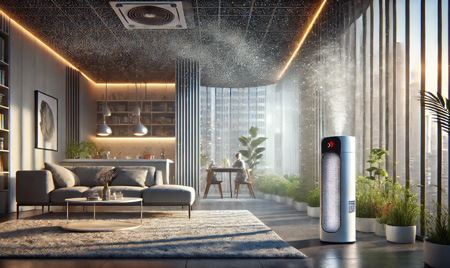Hummingbird® Technology
Hummingbird® includes the most advanced air purification on the market. Initially used in high end labs and clean rooms, Energy Cloud® is bringing the technology to the general commercial market. Hummingbird patented technology has been tested and proven at USC’s BSL Level 3 lab / Keck School of Medicine to deactivate COVID-19 on the first pass through the system. As opposed to other systems that claim to deactivate in 30 minutes or 60 minutes, Hummingbird® instantly eradicates the virus as it passes through the system. Testing was done in one of the most comprehensive bio-aerosol tests ever performed with real-life airflows in a 5-ton Air Handler HVAC system.
Patented Quality made in the USA
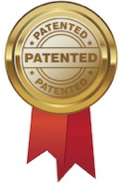 |
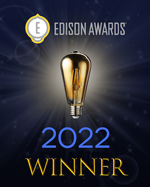 |
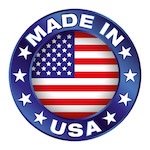
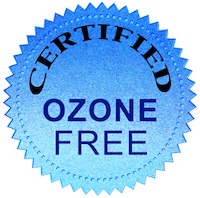 |
Hummingbird® Technology
Hummingbird Photocatalytic Oxidation
The hummingbird® utilizes our proprietary and patented version of Photocatalytic Oxidation as one of the core technologies for viral disinfection and VOC decomposition.
Hummingbird® photocatalytic oxidation includes UVC light at a specific wavelength saturating a matrix of Titanium Dioxide. This technology is extremely effective against viruses as proven by deactivating a 3,000x infectious
dose of aerosolized COVID-19 in USC’s BSL Level 3 lab and also decomposes VOC’s (Volatile Organic Compounds) including Ozone, Carbon Monoxide and Formaldehyde.
Note: UV light alone does not do what photocatalytic oxidation is capable of such as VOC decomposition.
Photocatalytic Process
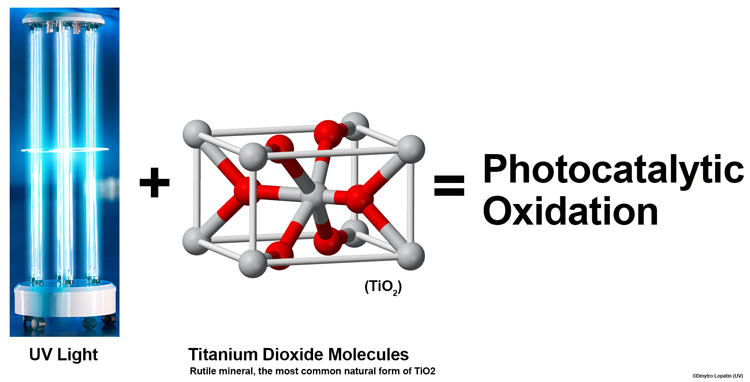 Hummingbird® Photocatalytic Process:
Hummingbird® Photocatalytic Process:
Decomposition of VOC's (volatile organic compounds) & Virus Deactivation
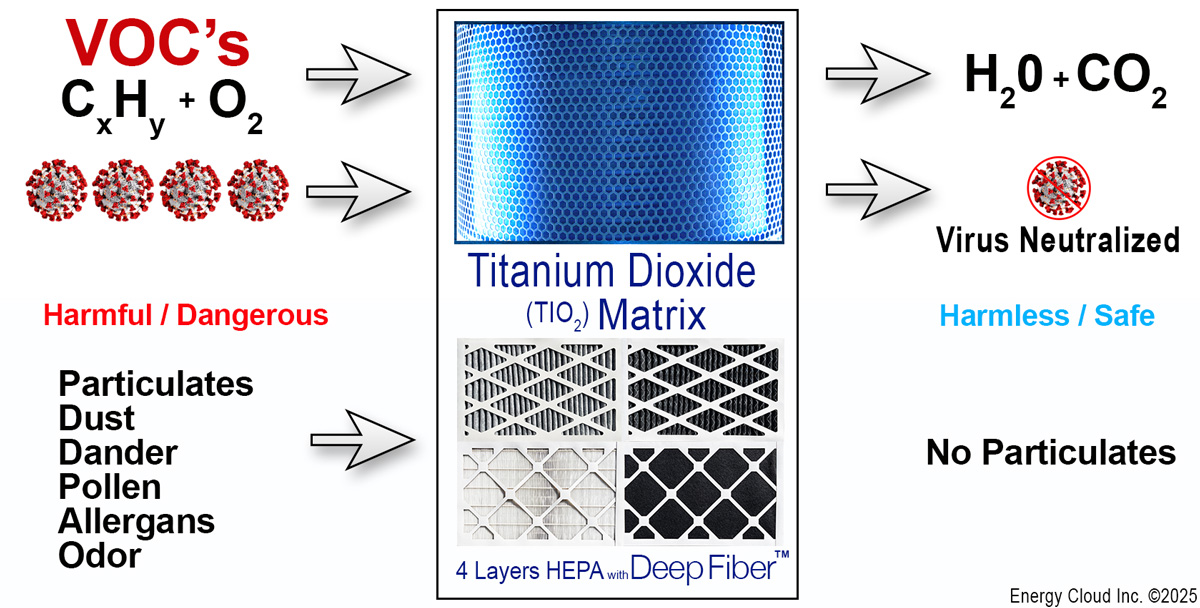
photocatalytic oxidation air quality mitigation matrix
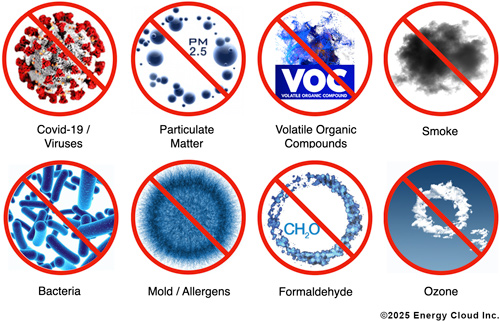
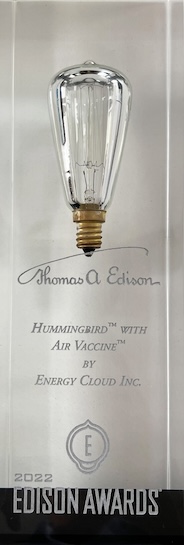
Hummingbird® Medical Testing
Energy Cloud’s Unmatched Real-World Testing: The Gold Standard in Air Purification Validation
At Energy Cloud, we don’t just claim efficacy—we prove it through the most rigorous, independent, and scientifically validated testing available. Unlike many competitors who rely on controlled lab conditions, surrogate viruses, or theoretical models, we take a real-world application approach that sets the highest industry standard.
Independent Testing at USC Keck School of Medicine’s BSL-3 Lab
While other companies use for-profit laboratories, we ensured our testing was conducted at the University of Southern California’s Keck School of Medicine, one of the leading academic research institutions in the world. The testing took place in a Biosafety Level 3 (BSL-3) laboratory, required for working with aerosolized, infectious SARS-CoV-2, ensuring results were validated under strict, high-containment conditions.
Peer-Reviewed by Top Experts
To ensure complete transparency and scientific rigor, we assembled an independent team of 10 epidemiologists and engineers from both academia and industry. This team was responsible for overseeing, reviewing, and validating our testing, making sure our results met the most stringent standards and were future-proofed against scrutiny.
Testing with Actual Live Covid-19, Not Surrogates
Unlike many competitors that rely on surrogate viruses that only approximate the behavior of SARS-CoV-2, our tests used the actual live Covid-19 virus. This guarantees that our results are directly applicable to real-world pandemic conditions, rather than theoretical extrapolations.
Realistic HVAC Airflows for Commercial & Residential Systems
Standard laboratory tests often fail to replicate how air moves through actual buildings. Our testing was conducted in airflows that mirror real-world HVAC systems in both residential and large-scale commercial buildings. This ensures the Hummingbird® Air Purification System performs effectively where it matters most—inside occupied spaces.
Extreme Viral Load Testing – 3,000x Infectious Dose
We pushed our testing to the extreme by exposing the system to 3,000 times the typical infectious dose of SARS-CoV-2 found in real-world scenarios. This ensures that even in environments with high viral loads—such as hospitals, office buildings, and schools—the Hummingbird® system can effectively neutralize and eliminate airborne threats.
Proven Effectiveness Against Major Covid-19 Variants
Viruses mutate, and a purification system must keep up. Unlike companies that only test against the original SARS-CoV-2 strain, our research covered major variants, including Beta, Delta, Omicron, and BA.2. The results conclusively show that the Hummingbird® Air Purification System remains highly effective against evolving Covid-19 threats.
Breakthrough Testing with the ABATE™ System
To overcome the biosafety limitations of traditional laboratory testing, a pioneering system was developed—ABATE™ (Airborne, Biological, Assessment, Threat, Elimination). This patented system was specifically designed to simulate real-world HVAC airflows while maintaining BSL-3 and BSL-4 safety protocols. ABATE™ ensures that filtration and purification technologies are tested under the most realistic conditions possible, making it a revolutionary step forward in air purification research.
The Energy Cloud Difference: Setting a New Benchmark for Air Purification
By combining independent university-based testing, real-world HVAC conditions, extreme viral load challenges, and peer-reviewed oversight, we have created the most conclusive proof of efficacy in the industry. The Hummingbird® Air Purification System is not just theoretically effective—it is scientifically proven to neutralize airborne pathogens at a level unmatched by any competitor.
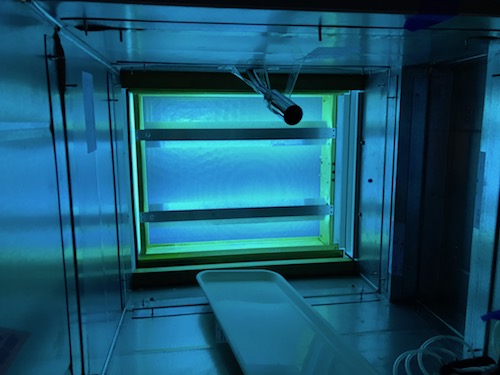 Hummingbird® tested at point of Nebeluzation in the
Hummingbird® tested at point of Nebeluzation in theABATE system (Airborne, Biological, Assessment, Threat, Elimination System)
*Tested at Keck School of Medicine at the University of Southern California BSL Level 3 Biosafety Lab. **Tested vs. Beta, Delta, Omicron & BA.2 Variants. Single-pass tests of hummingbird models: AP10000, AP30000, CP800 Portable / EL / WC HDAZ models
Carrieri Testing Protocol
The Carrieri Protocol: A New Standard for Airborne Pathogen Testing
In the pursuit of ensuring the highest efficacy in airborne virus mitigation, John Carrieri, CEO of Energy Cloud®, pioneered a groundbreaking approach to real-world air purification testing. Over two years of rigorous airflow and efficacy studies, Carrieri not only conceptualized and implemented these tests but also personally built the ABATE™ (Airborne, Biological, Assessment, Threat, Elimination) system, a patented testing framework designed to accurately evaluate air purification technologies under real-world conditions. His collaboration with a team of independent epidemiologists and engineers led to the development and perfection of what is now known as the Carrieri Protocol.
Defining the Carrieri Protocol
The Carrieri Protocol sets a new gold standard in air purification technology validation, ensuring that systems designed to combat airborne pathogens are tested under stringent, real-world conditions. The protocol outlines key elements that any technology must meet to demonstrate proven efficacy against airborne viruses in real-world building environments.
Key Elements of the Carrieri Protocol
1. Real-World HVAC Airflows
Testing must replicate the airflow conditions found in actual buildings. The standard airflow condition is set at 2,000 CFM per 5-ton HVAC unit (Heating, Ventilation, and Air Conditioning). This ensures that testing reflects how air moves through ventilation systems in both residential and commercial spaces.
2. Testing with the Actual Virus, Not Surrogate Viruses
Unlike many industry tests that rely on surrogate viruses, the Carrieri Protocol mandates testing with the actual airborne virus to obtain accurate and applicable results. Only by using the real pathogen can technologies prove their ability to neutralize airborne threats effectively.
3. Infectious Dose Testing Based on Building Type
To account for real-world exposure risks, testing must reflect the concentration of viral load expected in various building environments. The standard infectious dose levels are as follows:
- Large Buildings: 3,000x infectious dose per test
- Medium-Large Buildings: 2,500x infectious dose per test
- Medium Buildings: 2,000x infectious dose per test
- Small Buildings: 1,500x infectious dose per test
These dosages ensure that purification technologies can perform under maximum building occupancy real-world conditions, factoring in air dilution effects caused by the HVAC system and building air volume as well as occupant density.
4. Efficacy Ratings Must Focus on Virus Neutralization, Not Just Filtration
The true measure of an air purification system’s effectiveness is its ability to deactivate and neutralize the virus, rather than merely capturing it on a filter. Technologies that prove virus deactivation should be rated significantly higher than those that only collect pathogens without rendering them inactive.
5. Single-Pass Neutralization as the Highest Standard
The Carrieri Protocol establishes a tiered efficacy ranking based on how quickly a system neutralizes airborne pathogens:
- Single-Pass Neutralization: The highest level of efficacy, requiring deactivation in a single pass through the system.
- Multi-Pass Neutralization: Rated lower than single-pass but still more effective than prolonged exposure-based technologies.
- Long-Term Deactivation: Systems that require 30, 60, or more minutes to neutralize the virus are rated at the lowest level.
By prioritizing single-pass technologies, the Carrieri Protocol ensures that systems can provide immediate protection in occupied spaces.
6. Emission-Free Technologies as the Preferred Standard
Air purification technologies that do not emit additional substances into the air are rated higher than those that introduce chemicals or particulates. Emission-based technologies can potentially impact human health, particularly individuals with respiratory sensitivities. The safest solutions are those that effectively neutralize viruses without altering indoor air composition.
7. Preference for Independent Academic Testing Over For-Profit Labs
While testing at for-profit labs is permissible and acceptable, the Carrieri Protocol establishes a higher credibility ranking for independent academic institutions. University-based research facilities, such as the Keck School of Medicine at the University of Southern California, adhere to more rigorous and unbiased testing methodologies, ensuring greater scientific integrity and transparency.
Raising the Bar for Pandemic Mitigation
The Carrieri Protocol represents a fundamental shift in how air purification technologies are evaluated. By mimicking real-world conditions, utilizing actual viruses, and emphasizing single-pass neutralization, the protocol ensures that only the most effective solutions are recognized and implemented.
By following this standard, Energy Cloud® and its Hummingbird® Air Purification System continue to lead the industry in scientifically proven, real-world virus mitigation, setting a precedent for the future of airborne pathogen protection in commercial and residential buildings worldwide.
*Tested at Keck School of Medicine at the University of Southern California BSL Level 3 Biosafety Lab. **Tested vs. Beta, Delta, Omicron & BA.2 Variants. Single-pass tests of hummingbird models: CP800 Portable / EL / WC HDAZ models
Hummingbird® Quality Sensors
The hummingbird® IAQ Monitor and hummingbird® AI use high quality sensors producing superiour products built to last. A typical particulate sensor will only last 4 years, whereas our particulate sensor can run 24 hours per day for 10 years. Sensor quality is also very important as to accuracy. Our goal is to provide a true picture of health of your indoor air quality and HVAC systems and therfore have invested in the best technological sensors to ensure the best customer experience.
IAQ Sensors:- C02
- VOC’S
- Formaldehyde
- Particulates 1PM, 2.5PM, 4PM, 10 PM (Mass)
- Particulates .5PM, 1PM, 2.5PM, 4PM, 10 PM (Number)
- Particulates Average Size
- NOx
- Temperature +-2ºC
- Humidity +-2%RH
- Barometric Air Pressure
- Light(Lux)
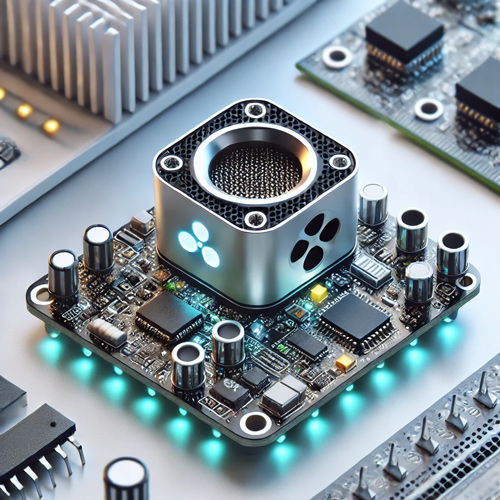
Hummingbird® Sensors
Hummingbird® Filtration Technology
The hummingbird® systems come with either a MERV-13 or HEPA filter(s) depending on the model. The MERV-13 provides excellent performance while not overburdening the HVAC system with excess static pressure which leads to increased energy costs. But depending on the application and need we also have HEPA and Ultra HEPA filters.
The hummingbird® premium filters also uses Deep Fiber™ technology which includes a special filter material construction that traps up to 4X more fine particles as compared to a conventional filter. This provides for improved particulate capture performance and also lengthens the life of the filter, saving on overall life cycle replacement costs and labor.
Deep Fiber™
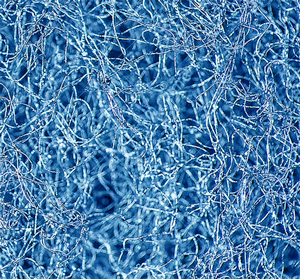
UV Clarification (Pros & Cons)
The Hummingbird® systems include UV but utilize them in a different way than most systems. UVC light works effectively at deactivating viruses but works with a time and exposure model. The longer the light has to focus on a subject, the greater its ability to deactivate a virus or biological. One such use in an HVAC system with when UV is installed and focused on an HVAC coil. This is a perfect application where the light can help keep the coil clean. What is not properly understood though is that with the actual airflows of air found in an HVAC system (ie 1600-2000 cfm / 5 tons of HVAC), the air goes by too quick to completely and effectively deactivate viruses, bacteria and other biologicals in the air.
What Hummingbird® uses UVC light for is to hit the Titanium Dioxide Matrix that runs through the whole airflow area of the hummingbird and when the UVC light interacts with the Titanium Dioxide Matrix, it creates the photocatalytic oxidation process that deactivates (neutralizes) viruses and decomposes VOC's (volatile organice compounds).
UV (Ultraviolet UVC Lamp)

Hummingbird® AHU includes UVC commercial lamps with Easy Maintenance.
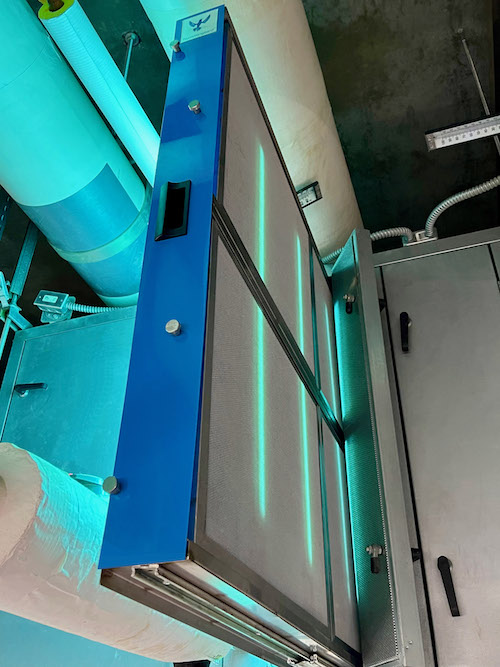
The Potential Dangers and Limitations of Certain Air Purification Technologies
Introduction
Air purification technologies play a critical role in improving indoor air quality, but not all solutions are equally effective or safe. Many air purification methods, despite their marketing claims, have limitations and potential health risks. Technologies such as ionization, ozone emission devices, and dry hydrogen peroxide (DHP) have raised concerns due to their lack of efficacy against airborne diseases, potential health hazards, and weak supporting research. Additionally, many air purifiers claim to neutralize airborne viruses and VOCs but do so only after prolonged exposure times, making them ineffective in real-world scenarios. Furthermore, some technologies are limited to specific air quality issues while leaving significant gaps in protection with respect to total air quality and building health.
The Dangers and Inefficacy of Certain Air Purification Methods
1. Ozone-Generating Devices: A Serious Health Hazard
Some air purifiers intentionally emit ozone as part of their purification process, claiming it helps to neutralize pollutants. However, ozone is a harmful gas that can damage lung tissue, exacerbate respiratory diseases, and trigger asthma attacks. The EPA warns against indoor ozone generators, stating that they can cause more harm than good.(1) Even in low concentrations, prolonged exposure to ozone can lead to coughing, chest pain, and reduced lung function.
2. Ionization: Overstated Claims and Legal Issues
Ionization-based air purifiers claim to neutralize airborne pathogens by charging particles so they cluster together and can be filtered out more easily. However, real-world studies have found that ionization is not effective at addressing COVID-19 or other airborne diseases. Some products using this technology have faced class-action lawsuits due to misleading claims about their efficacy.(2)(3) Studies have also indicated that ionization can generate ozone as a byproduct, which is a known lung irritant and can worsen respiratory conditions such as asthma.
3. Dry Hydrogen Peroxide (DHP):
Insufficient Research and Potential Risks
DHP, initially developed for disinfecting unoccupied rooms, is now being marketed as a continuous air purification method. However, long-term exposure to airborne hydrogen peroxide has not been sufficiently studied for respiratory safety, especially in regards to those that have sensitive respiratory issues. Because it was originally designed for sterilizing empty spaces, its impact on human lungs when used in occupied environments remains uncertain. Without thorough safety validation, DHP exposure could pose unknown risks to respiratory health(4).
4. Technologies That Emit Substances into the Air
Beyond ionization, ozone, and DHP, any air purification technology that releases chemicals, ions, or particles into the air introduces an additional unknown variable to indoor air quality. These systems alter the air composition rather than simply removing contaminants, potentially leading to new health risks that are not fully understood. Instead of solving air quality problems, these methods could introduce secondary pollutants that have long-term effects on health.
Misleading Claims About Airborne Virus and VOC Removal
1. Delayed Virus Neutralization: A False Sense of Security
Many air purification technologies claim to deactivate airborne viruses, but when reviewing their actual research reports, the tests often show virus neutralization occurring only after 30–60 minutes. In real-world situations, this delay is meaningless—by the time a virus is neutralized, occupants would have already been exposed and infected. A truly effective air purification system needs to remove and neutralize airborne pathogens in real-time to provide meaningful protection.
2. Inefficient VOC Removal: Extremely Long Processing Times
Volatile organic compounds (VOCs) are toxic gases released from building materials, furniture, and cleaning products. Many air purification devices claim to mitigate VOCs, but closer examination of performance graphs and research data often reveals that they take 8–12 hours or longer to significantly reduce VOC levels. In real-life conditions, occupants continue breathing in harmful chemicals for extended periods before the purifier takes effect, making these claims misleading.
Gaps in Air Purification Capabilities:
Partial Solutions Leave Health Risks
Many air purification products fail to address all critical air quality threats, leaving gaps in protection:
- MERV and HEPA Filters: While excellent at capturing particulates, these filters do not neutralize viruses, bacteria, VOCs, or other harmful gases.
- UV Light Purifiers: UV disinfection works for certain biological contaminants, but it does not remove VOCs, formaldehyde, or other chemical pollutants.
- Inadequate Testing in Real-World Airflow Conditions: Many air purifiers claim whole-house or commercial coverage, yet their tests were conducted in controlled laboratory conditions that do not represent real HVAC airflow dynamics. Without real-world validation, their effectiveness in active ventilation systems is questionable at best.
Conclusion:
The Risks and Limitations of Many Air Purification Technologies
When evaluating air purification solutions, it is critical to look beyond marketing claims and examine actual research data. Many technologies that boast 99.x% effectiveness fail to mention that:
- Virus neutralization takes too long to prevent airborne disease transmission.
- VOC reduction happens over many hours (8+), leaving occupants exposed to harmful chemicals.
- Some products emit secondary pollutants that pose additional health risks.
- Partial filtration solutions (HEPA, UV, etc.) leave critical gaps in protection.
- Many products fail real-world airflow testing, reducing their practical effectiveness.
Why the Hummingbird® Air Purification System Stands Apart
Unlike many air purifiers that only address one or two aspects of air quality, the Hummingbird® Air Purification System is a comprehensive solution that:
- ✅ Neutralizes Covid-19 (99.99%) on the First Pass5.
- ✅ Neutralizes SARS-CoV2 variants on the First Pass5.
- ✅ Neutralizes viruses, bacteria, and biological contaminants.
- ✅ Removes particulates (PM2.5, PM10) efficiently.
- ✅ Eliminates allergens, mold spores, and smoke particles.
- ✅ Breaks down VOCs, formaldehyde, and other harmful gases.
- ✅ Uses photocatalytic oxidation (PCO) with no harmful emissions.
- ✅ Works in real-world airflow conditions, ensuring effectiveness in HVAC systems5.
With Hummingbird®, you get an air purification system that truly enhances indoor air quality without compromise—safely, effectively, and without misleading claims.
1 Ozone Generators that are Sold as Air Cleaners -U.S. EPA
2 Needlepoint Bipolar Ionization Devices Subject of Lawsuit - FacilitiesNet
3 Do air purifiers protect against Covid? Lawsuit says company makes 'false' claims - NBC
4 Health risk assessment of inhalation exposure to dry fogging of hydrogen peroxide in
a dental clinic during the COVID-19 pandemic. - NIH (National Library of Medicine)
5 Hummingbird Efficacy Study: USC BSL Level 3 lab / Keck School of Medicine
Ozone, Ionization, DHP and other emitting technologies
